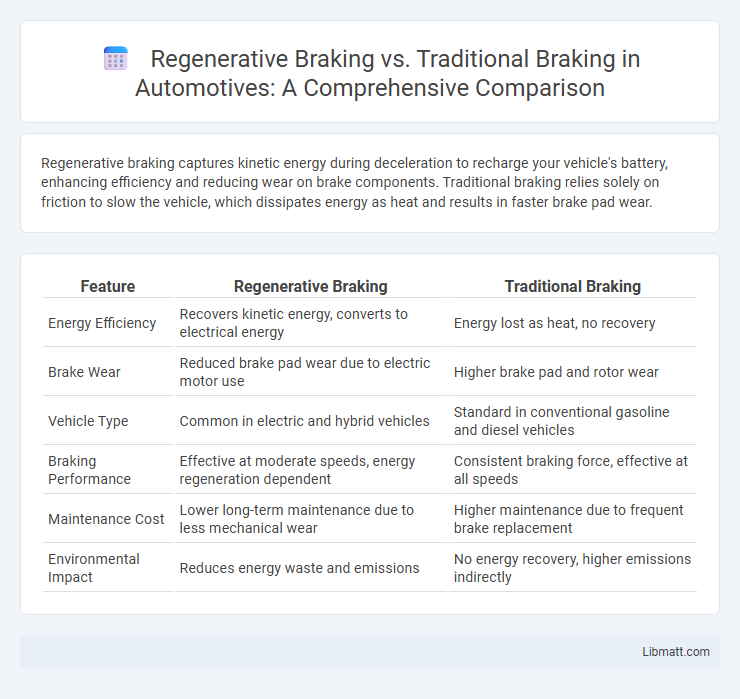Regenerative braking captures kinetic energy during deceleration to recharge your vehicle's battery, enhancing efficiency and reducing wear on brake components. Traditional braking relies solely on friction to slow the vehicle, which dissipates energy as heat and results in faster brake pad wear.
Table of Comparison
| Feature | Regenerative Braking | Traditional Braking |
|---|---|---|
| Energy Efficiency | Recovers kinetic energy, converts to electrical energy | Energy lost as heat, no recovery |
| Brake Wear | Reduced brake pad wear due to electric motor use | Higher brake pad and rotor wear |
| Vehicle Type | Common in electric and hybrid vehicles | Standard in conventional gasoline and diesel vehicles |
| Braking Performance | Effective at moderate speeds, energy regeneration dependent | Consistent braking force, effective at all speeds |
| Maintenance Cost | Lower long-term maintenance due to less mechanical wear | Higher maintenance due to frequent brake replacement |
| Environmental Impact | Reduces energy waste and emissions | No energy recovery, higher emissions indirectly |
Introduction to Braking Systems
Braking systems are essential components in vehicles, converting kinetic energy into heat or electrical energy to reduce speed or stop motion. Traditional braking relies on friction between brake pads and rotors, generating heat and causing energy loss. Regenerative braking recovers kinetic energy during deceleration, converting it into electrical energy stored in the battery for enhanced energy efficiency and reduced wear on mechanical components.
What is Regenerative Braking?
Regenerative braking is an energy-efficient technology in electric and hybrid vehicles that recovers kinetic energy during deceleration by converting it into electrical energy, which recharges the battery. Unlike traditional braking systems that rely solely on friction to slow the vehicle, regenerative braking reduces wear on brake components and enhances overall energy efficiency. Your vehicle benefits from improved fuel economy and reduced emissions by utilizing this innovative braking method.
Understanding Traditional Braking Mechanisms
Traditional braking mechanisms rely on friction to slow down or stop a vehicle by pressing brake pads against a rotating disc or drum, converting kinetic energy into heat. This method leads to energy loss and requires frequent replacement of brake components due to wear and tear. Understanding these basic principles helps highlight the efficiency advantages regenerative braking offers by capturing and reusing energy instead of dissipating it.
Key Components of Regenerative Brakes
Regenerative braking systems primarily consist of key components such as the electric motor/generator, battery pack, and power electronics controller. The electric motor functions as a generator during braking, converting kinetic energy into electrical energy that is stored in the battery for future use. Advanced sensors and control units optimize the energy recovery process, enhancing overall vehicle efficiency and reducing wear on traditional friction brake components.
How Traditional Braking Works
Traditional braking systems work by applying friction to the wheels using brake pads and rotors, converting kinetic energy into heat that dissipates into the environment. This friction-based process slows down the vehicle but results in energy loss, as the kinetic energy is not recovered or reused. Your vehicle's braking efficiency relies heavily on the condition of these mechanical components and their ability to generate sufficient friction for safe stopping.
Energy Efficiency Comparison
Regenerative braking captures kinetic energy during deceleration, converting it into electrical energy stored in the battery, significantly enhancing overall energy efficiency compared to traditional friction braking, which dissipates this energy as heat. This energy recovery in regenerative systems can improve fuel economy in hybrid and electric vehicles by up to 20-30%, reducing reliance on external power sources. Your vehicle benefits from lower energy consumption and decreased wear on brake components, leading to cost savings and environmental advantages over conventional braking methods.
Impact on Vehicle Maintenance
Regenerative braking significantly reduces wear on brake pads and rotors by converting kinetic energy into electrical energy, thereby decreasing the frequency of brake system replacements. Traditional braking systems rely solely on friction, which accelerates the degradation of brake components and increases maintenance costs over time. Vehicles equipped with regenerative braking benefit from lower long-term maintenance expenses and enhanced component longevity.
Environmental Benefits
Regenerative braking systems capture and convert kinetic energy into electrical energy, reducing overall energy consumption and lowering greenhouse gas emissions. Traditional braking dissipates energy as heat, causing no energy recovery and increased wear on brake components, leading to more frequent replacements and waste. You can significantly reduce your vehicle's environmental impact by choosing regenerative braking technology, which supports energy efficiency and sustainability.
Cost Implications
Regenerative braking systems can reduce long-term maintenance costs by decreasing wear on brake pads and components, leading to fewer replacements compared to traditional braking systems. While the initial installation cost of regenerative braking technology is higher, the energy recuperation helps improve overall vehicle efficiency and lowers fuel or electricity expenses, offsetting upfront investments. Your choice between these systems should consider the balance of upfront costs versus ongoing savings in maintenance and energy consumption.
Future Trends in Braking Technology
Future trends in braking technology emphasize the integration of regenerative braking systems with advanced electronic controls to enhance energy efficiency and reduce carbon emissions in electric and hybrid vehicles. Innovations in materials science are driving the development of smarter friction brakes featuring sensors and adaptive modulation for improved safety and durability. The convergence of regenerative braking with autonomous driving technology promises to optimize braking performance through predictive algorithms and real-time data analytics.
Regenerative Braking vs Traditional Braking Infographic

 libmatt.com
libmatt.com